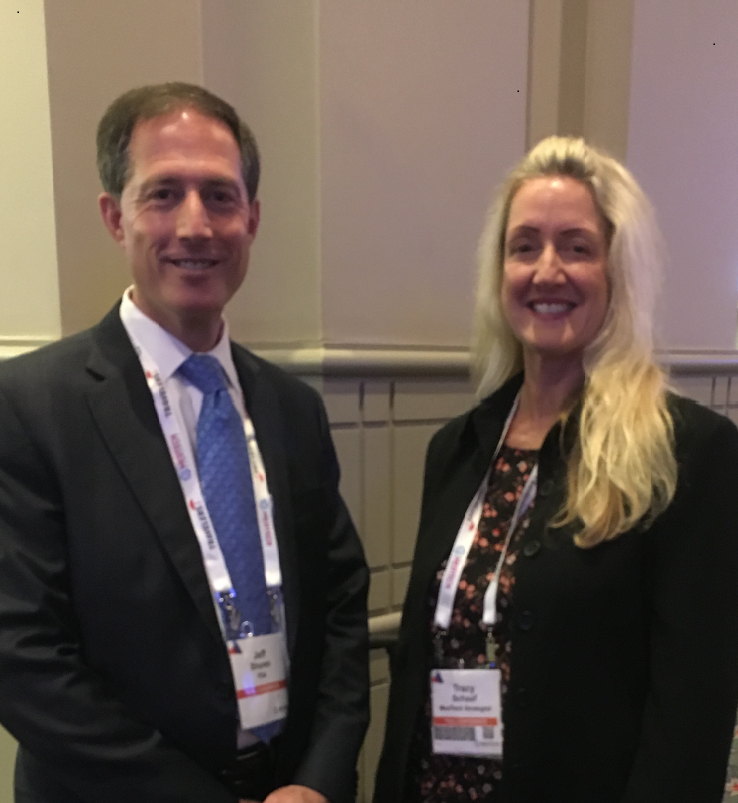ARTICLE SUMMARY:
At the recent MedTech Conference powered by AdvaMed, the Community Blog caught up with Jeffrey Shuren, MD, JD, Director, Center for Devices and Radiological Health (CDRH) at the FDA. We asked him what he thought about today’s medical device regulatory climate, and where he sees the industry overall headed in the next few years. The key theme here is "community."
Q. How would you characterize the current FDA medical device regulatory climate?
A. “I’m optimistic about the medical device regulatory climate. Our vision is that patients in the US have access to high-quality, safe and effective medical devices of public health importance, ‘first in the world.’ ‘First in the world’ is not about a competition between countries but recognizing that technology can benefit patients, But, it is of limited value to them if they don’t have timely access. That’s what ‘first in the world’ is about.

We’ve been making a lot of important changes in the [CDRH] program, to both spur innovation, speed along timely access, but also assuring that devices are higher quality, safer, more effective. And, you can see the results of what we’ve been doing, by the increase in the number of novel technologies that we have been approving in the US marketplace. From 2009 to last year, that number has increased four-fold: last year we approved 95 novel technologies, and that was the highest in the 40-year history of the program. So, I think the future is bright, we do still have a ways to go, but it’s very encouraging what we’re seeing.”
(Note that “novel technologies” according to the FDA include original PMAs, panel track supplement PMAs, and de novos; 24 novel technologies were approved by the agency in 2009.)
Q. Are there specific medical device innovations that you and the CDRH are especially excited about right now, and why?
A. “There are a lot of medical device innovations that are going on. I couldn’t tell you that there’s only one we’re excited about, but there are some really important trends going on. Of course everything’s going digital, and the whole value of connectivity and the opportunities for using machine learning and artificial intelligence. In addition, more and more noninvasive surgeries, the use of robotics and miniaturization, as well as a lot of the cell-based technologies that are attaching onto medical devices. I see these as critically important trends as we are moving into the future. Very, very exciting to see.
Where we’re headed ultimately, in the next few years, is truly a symbiotic relationship between people and their technologies. It’s not just simply: I use a device to accomplish something. That device becomes integral to how you behave in your environment – even to how you may think about the things that you do.”
Q. Looking out five years, where do you see the greatest need for medical device innovation?
A. “When I look out five years from now, actually rather than a need, I see a tremendous opportunity. That is, the power of the community.
We’re used to solving problems sometimes with one-off collaborations, but we think about certainly from a governing standpoint, more of a ‘command and control’ today in how to solve things: government’s in charge, we’re going to get those answers, happy for you to provide input, but we’ll tell you what to do.
For us, that’s just the wrong model. The best way to solve problems and achieve outcomes is to do it in collaboration. That means, we do it on an ongoing basis, and to truly be effective, the community has to take charge.
One of our strategic priorities is something called ‘Collaborative Communities.’ It’s an ongoing forum where public and private sector stakeholders who are interested in a particular area come together to achieve those shared outcomes and solve those shared problems. And they do that on a continuous basis.
That’s a very different approach than today. It means that the community is working on the solutions. What it means for government like the FDA is that we are a willing participant. We’re not leading it, we’re a member of that community. That means if the community wants to go in a particular direction, then we should go there. Unless it’s contrary to our statutory mandate, or not in the best interest of public health.
There are lots of ways to get to ‘yes.’ The power of the community can get us to better solutions. That brings more people to the table, and ultimately then gets a better buy-in from the community. To get there, that means government has got to change, and that’s why we’ve made it a strategic priority. I see in the next five years, you’re going to see a whole bevy of collaborative communities, and that’s going to be the traditional way in which we do business.
Isn’t that what innovation is about? It’s about bringing together people from different worlds – that’s where the truly great ideas come from.”
Q. What about your job gives you the most personal satisfaction?
A. “The interactions with my colleagues at the FDA. I take tremendous satisfaction from the impact we have on patients’ health, but I don’t get to see it at the bedside all the time. Not like when I was in clinical practice. But what I do see are those engagements with my staff, and I have to say for all the jobs I’ve held over the years, I’ve never been with a more professional, forward-leaning, smart group of people that I have at the Center for Devices and Radiological Health. It just invigorates me, and makes me want to get up in the morning and get to work.”
Q: What or who influenced you to get into the healthcare space?
A. “It was my Dad. My Dad was a retired dentist, and he always had a passion for healthcare and science. I learned that from him. And, I became a neurologist because I became fascinated with the brain when I was a little kid. Kids would collect their sports paraphernalia, and I would collect preserved animal brains to study.”
More About Dr. Shuren:
Dr. Shuren received his BS and MD degrees from Northwestern University under its Honors Program in Medical Education. He completed his medical internship at Beth Israel Hospital in Boston, his neurology residency at Tufts New England Medical Center, and a fellowship in behavioral neurology and neuropsychology at the University of Florida. He received his JD from the University of Michigan.
He has held various policy and planning positions within FDA from 1998 to 2009, including acting deputy commissioner for policy, planning, and budget; associate commissioner for policy and planning; special counsel to the principal deputy commissioner; assistant commissioner for policy; and medical officer in the Office of Policy. Dr. Shuren has served in a leadership role at FDA or on behalf of the agency on numerous initiatives, including:
-
Reauthorization of the Medical Device User Fee Act, which dramatically shortens review times for device applications
-
Creation of the Sentinel Initiative, which works toward a national electronic system for monitoring medical product safety
-
Development of FDA’s Pandemic Influenza Preparedness Strategic Plan
-
Development of FDA’s Counterfeit Drug Task Force Report
-
Development of the Interagency Food Safety Working Report to the President
-
Implementation of FDA provisions of the Medicare Prescription Drug Improvement and Modernization Act
-
Development and implementation of the Interagency Import Safety Working Group’s Report to the President: Action Plan for Import Safety
(Source: FDA)
#JeffreyShuren #FDA #CDRH #regulatory #PMA #noveltechnologies #innovation #machinelearning #artificialintelligence #digitalhealth #brain #neurology #robotics #miniaturization #noninvasivesurgery #cell-based #CollaborativeCommunities #medicaldevice #medtech #CommunityBlog #MedTechStrategist #tracyschaaf
![]() Trial MyStrategist.com and unlock 7-days of exclusive subscriber-only access to the medical device industry's most trusted strategic publications: MedTech Strategist & Market Pathways. For more information on our demographics and current readership click here.
Trial MyStrategist.com and unlock 7-days of exclusive subscriber-only access to the medical device industry's most trusted strategic publications: MedTech Strategist & Market Pathways. For more information on our demographics and current readership click here.
